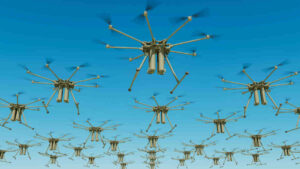New industry research confirms the importance of Elsight’s multi-network technology in drone production

Pic: Justin Paget / DigitalVision via Getty Images
Special Report: The study, carried out by Nokia Bell Labs in Denmark, is further validation of how Elsight’s patented Halo technology will play a key role in the global drone market.
As the $US100 billion global drone industry continues to develop, the number of use-cases for drone technology also increases.
Industries looking at applications for the technology included security & defence, government infrastructure, and even gaming and esports.
But across that broad spectrum, one of the more developed markets in the space is utilising drone tech for commercial purposes, such as product delivery and improving on-site specifications for building construction.
To be effective, commercial drones need to operate in connection with local network communication systems.
And in view of that, the recent research from Nokia Bell Labs took the concept a step further by running tests to determine how cellular networks can be optimised for commercial drone flights that travel beyond the visual line of sight of the operator.
The testing showed categorically that drone flight reliability is vastly improved by the use of at least two cellular network links.
And with the weight of evidence mounting, it’s increasingly likely that the use of multi-network links will be prescribed in the developing regulatory frameworks around commercial drone flights.
One company that stands to benefit from that increased regulatory certainty is Elsight (ASX:ELS), which sells its patented Halo technology to original equipment manufacturers (OEMs).
Halo offers an enhanced method for users to send and receive data and HD video over cellular networks. Instead of relying on one network, the technology allows for data and HD video transmission across up to four different channels.
The technology allows for video streaming and sensor technology, as well as two-way communications. Data can be encrypted, streamed or resent to other devices, all within 200 milliseconds.
Elsight CEO Nir Gabay said it’s now becoming “increasingly clear” that aviation regulators will mandate all drone communication systems will need to have “a minimum of two cellular networks.”
“Moreover, studies such as the one by Nokia Bell Labs in Denmark have provided invaluable validation of the claims that we have been making for some time — that using a minimum of two IP links/cellular networks greatly improves reliability,” Gabay said.
Gabay also highlighted that the study downplayed the impact of the pending rollout of 5G networks on drone technology, due to the fact that 5G antennas point down, not up.
“When all of this information is crystallised together, the conclusion is undeniable – Halo is coming to market at the exact right time, and is a necessity for the operation of long-range drone flights beyond the visual line of sight.”
This story was developed in collaboration with Elsight, a Stockhead advertiser at the time of publishing.
This story does not constitute financial product advice. You should consider obtaining independent advice before making any financial decisions.
UNLOCK INSIGHTS
Discover the untold stories of emerging ASX stocks.
Daily news and expert analysis, it's free to subscribe.
By proceeding, you confirm you understand that we handle personal information in accordance with our Privacy Policy.








